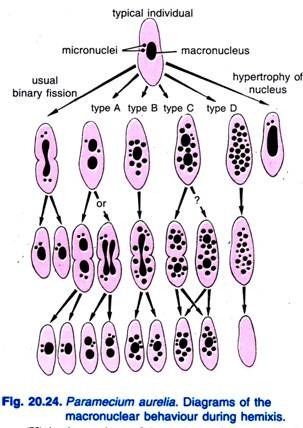The mechanism of humoral immunity is accomplished after interaction of antigen with B-cells, antibody production and antigen-antibody binding.
1. Interaction of antigen with B-cells:
The B-cells after production from the stem cells (Fig. 22.8) migrate to lymphoid organs. When antigen interacts and contacts the receptor, the later gets stimulated. The B-cells differentiate into antibody producing cells through three steps: activation, proliferation and differentiation (Fig. 22.8 A-C).
Moreover, from the beginning it passes through several stages such as lymphoid stem cell, progenitor B-cell, pre-B-cell, immature B-cell, mature B-cell, activated B-cell, plasma cell and memory cell.
The plasma cells divide to produce a large number of genetically identical cells known as clones. Some of the progeny cells are differentiated into the antibody producing cells i.e. plasma cells. The plasma cells secrete antibodies specific to antigens. Some of the other B-cells act as memory cells (Fig. 19.8B). Each plasma cell is capable to produce about 2,000 antibodies per second but they remain alive for a few days only.
2. Production of antibodies:
Antibody production may or may not depend on T-antigens.
Antibodies production against T-dependent antigens:
Antibody production by B-cells is also cooperated by the other cells such as T-cells and macrophages. For example, B-cells produce antibodies in cooperation with T-cells against a type of antigen known as T-dependent antigen (Fig. 22.9). The T-dependent antigen consists of bacteria, some of proteins, RBCs, etc.
The macrophages or dentric cells (highly branched cells) play a significant role. The B-cells need the help of antigen presenting cells (APC) (i.e. the macrophages and dentric cells that attack the T-dependent antigens and partially digest them) and specialized helper T-cells to produce antibodies against T-dependent antigens.
This process is accomplished in the following steps:
The APC attaches the T-dependent antigens and partially digests them. The APC usually takes up the polypeptide fragments of the antigen and keep them on the cell surface. The specific T-cells which are known as helper T-cells interact with the APC. The antigen fragments and certain self antigens are recognised by helper T-cells and carry them on the surface of APC.
The self antigens are actually the cell surface proteins that are the components of the major histocompatibility complex. They serve as the self antigens, the signals by which the immune system distinguishes the self from non-self.
The foreign antigen is recognised by the helper T-cells only when it gets combined with a self antigen on the surface of APC. This results in stimulation of suitable B-cells. For that the possession of self antigens by B-cells is very necessary.
Helper T-cells are required by all immune responses that induce IgG, Ig and IgE. However, a single complex of the antigen and the self antigen present on the cell surface of B-cells are recognised by T-cell receptors.
Antibody production against T-independent antigen:
The T-independent antigens, without the interference of T-cells, can also induce a response from B-cells. The T-independent antigens contain the repeating subunits of polysaccharide or protein, for example bacterial flagella (composed of proteins) and lipopolysaccharide layer of Gram-negative bacteria.
Multiple bonds are formed with B-cells by these antigens. But the immune response by these antigens is weaker as compared to T-dependent antigens. They bind to B-cells which produce antibodies only of the class IgM.
3. Antigen-antibody binding:
Lerner and Tramontano (1988) have nicely described how antigen binding sites or antibodies react with antigens. Specific antibody recognises the specific antigen. This depends on the ability of antibody. However, each antibody consists of antigen binding site on the variable region of light and heavy chains.
The complex of this binding is known as antigen- antibody complex which can protect the hosts by several ways such as neutralizing the toxin, inactivating the viruses, etc. The antibodies do not play beneficial role. They also can initiate allergy, can cause auto-immune disorder and also damage the host tissue.

